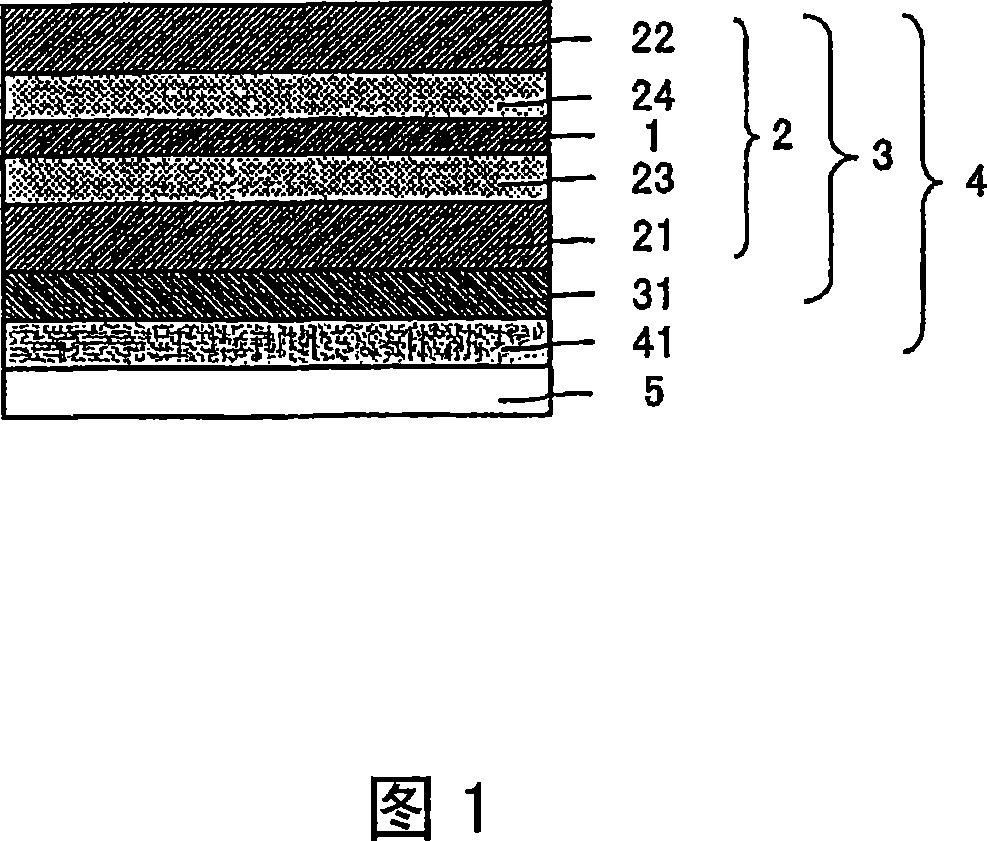Pressure-sensitive adhesive type polarizer with retardation layer, process for producing the same, optical film, and image display
一种相位差层、偏振片的技术,应用在粘合剂类型、光学、光学元件等方向,能够解决缺乏粘附性、不能跟随偏振片等问题,达到形状改善、抑制光学特性的变化、抑制脱层的效果
- Summary
- Abstract
- Description
- Claims
- Application Information
AI Technical Summary
Problems solved by technology
Method used
Image
Examples
Embodiment 1
[0198] (polarizer)
[0199] A 75 μm thick polyvinyl alcohol film having an average degree of polymerization of 2400 and a degree of saponification of 99.9 mol % was immersed in warm water at 30° C. for 60 seconds to swell. Next, the film was stretched by dipping in an iodine aqueous solution having a concentration of 0.4% of iodine / potassium iodide (weight ratio = 1 / 7), and dyed at a stretching ratio of 3.5 times. Then, stretching was carried out in a borate aqueous solution at 65° C. so that the total stretching ratio became 6 times, and further, it was immersed in an aqueous solution having a potassium iodide concentration of 3% at 30° C. for 5 seconds. After stretching, it was dried in an oven at 40° C. for 3 minutes to obtain a polarizer. The single transmittance of the polarizer is 42.4%.
[0200] (transparent protective film)
[0201] A triacetylcellulose film with a thickness of 80 μm was used.
[0202] (Transparent protective film with retardation layer)
[0203] ...
Embodiment 2
[0213] (polarizer)
[0214] In Example 1, a polarizer was obtained in the same manner as in Example 1, except that the concentration of the iodine aqueous solution was changed to 0.37%, and the single transmittance of the obtained polarizer was changed to 43.2%.
[0215] In Example 1, except having used the polarizer obtained above, it carried out similarly to Example 1, the polarizing plate with a retardation layer was produced, and the polarizing plate with an adhesive type retardation layer was further produced. The dimensional shrinkage rate of the polarizing plate with a retardation layer was 0.40%.
Embodiment 3
[0217] (preparation of adhesive)
[0218] Put 95 parts of butyl acrylate, 5 parts of acrylic acid, 0.1 part of 2-hydroxyethyl acrylate, 0.05 parts of 2,2'-azobisisobutyronitrile and ethyl acetate into a 4-necked flask equipped with a nitrogen introduction tube and a cooling tube. 200 parts of esters were sufficiently replaced with nitrogen, and then polymerized at 55° C. for 20 hours while stirring under a nitrogen stream to obtain an acrylic acid polymer with a weight average molecular weight of 1.57 million. With respect to 100 parts of the solid content of the above-mentioned acrylic polymer solution, 0.08 parts of 3-glycidoxypropyltrimethoxysilane was uniformly mixed, and further, toluene disulfide made of trimethylolpropane was uniformly mixed as a crosslinking agent. 0.8 parts of a polyisocyanate-based crosslinking agent composed of an isocyanate adduct was used to obtain an acrylic adhesive.
[0219] (Manufacture of adhesive type polarizing plate with retardation layer...
PUM
| Property | Measurement | Unit |
|---|---|---|
| saponification | aaaaa | aaaaa |
| particle diameter | aaaaa | aaaaa |
| angle | aaaaa | aaaaa |
Abstract
Description
Claims
Application Information
 Login to View More
Login to View More - R&D
- Intellectual Property
- Life Sciences
- Materials
- Tech Scout
- Unparalleled Data Quality
- Higher Quality Content
- 60% Fewer Hallucinations
Browse by: Latest US Patents, China's latest patents, Technical Efficacy Thesaurus, Application Domain, Technology Topic, Popular Technical Reports.
© 2025 PatSnap. All rights reserved.Legal|Privacy policy|Modern Slavery Act Transparency Statement|Sitemap|About US| Contact US: help@patsnap.com

